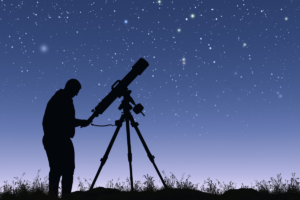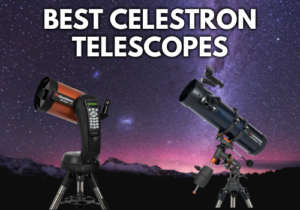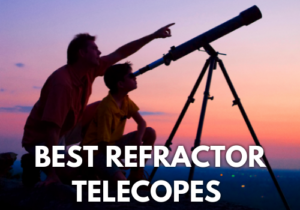
7 Best Computerized Telescopes 2026; Reviews
Disclosure: This post contains affiliate links and I may earn a small commission (at no extra cost to you) if you click through and make a purchase. Thanks in advance – I really appreciate it!
Here in this “Best Computerized Telescope” article we’ve rounded up 7 of the best computerized GoTo telescopes of various types, specifications, and budget perfectly suited for beginners, intermediates or advanced astronomers.. Below, you’ll find in-depth reviews of each, as well as an elaborate buying guide to help you pick out the one that suits you the most.
Our Top 3 Picks
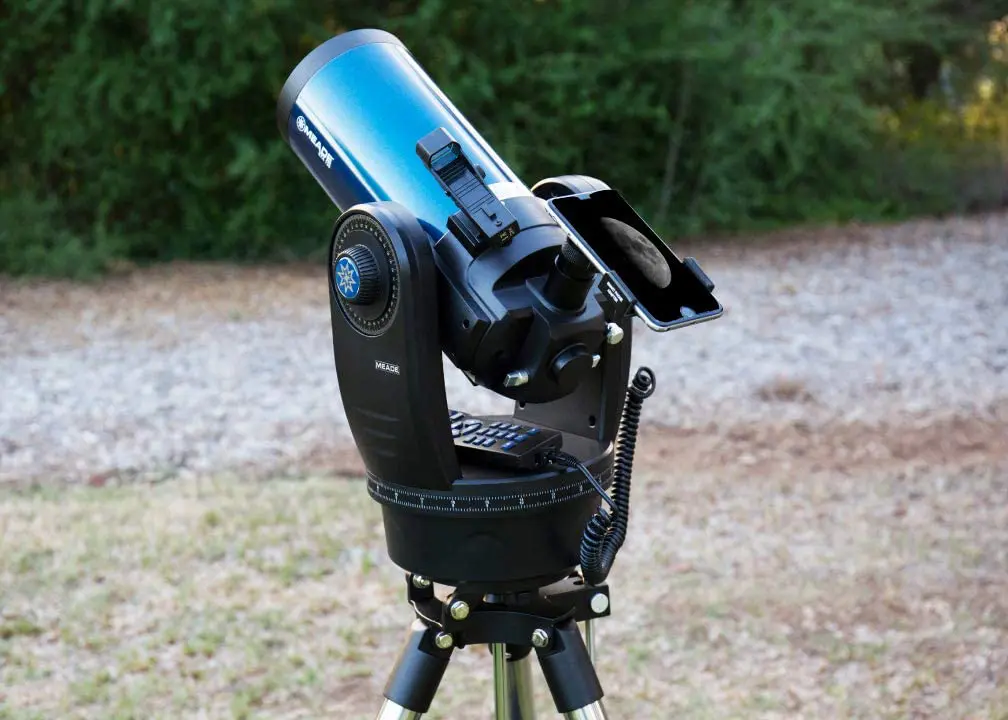
What are Computerized Telescopes?
With the assistance of a Computerized Telescope, the amateur astronomer can have their telescopes guide them through the night sky through a few basic initial steps (these steps can differ depending on what alignment system the telescope mount accepts).
With a simple computerized hand controller, time and date must be entered (if there is no built in GPS system) and the observer must slide to two named stars so the computerized GoTo mount can calculate coordinates accurately.
This is especially helpful if you are observing from a suburban setting, where light pollution may hinder your ability to see stars.
Many GoTo telescopes also have a built-in GPS system to make alignment even easier. With a GPS enhanced telescope, there is no need for lengthy data entry, such as date, time, or location. Your GPS-enhanced telescope will do it all for you.
Some computerized telescopes, called PushTo telescopes, are moved manually by the user, following instructions on the hand controller’s readout. Others, called GoTo telescopes, have electric motors that move the telescope automatically to the target.
Either way, once you try a computerized telescope, you won’t ever go back to searching for objects the old fashioned way.
Best GoTo Telescope
1. Celestron – NexStar 5SE
- ADVANCED TECH MEETS ICONIC DESIGN: The NexStar 5SE pairs Celestron’s legendary orange tube with a fully computerized GoTo system—ideal for those ready to step up from manual scopes and explore more of the night sky with precision and ease.
- 5-INCH SCHMIDT-CASSEGRAIN OPTICS: The 5" aperture gathers enough light to reveal fine lunar details, cloud bands on Jupiter, and deep-sky objects like galaxies and globular clusters—all in a compact, portable form factor.
- FULLY AUTOMATED GoTo MOUNT WITH NEXSTAR+ HAND CONTROL: Use the NexStar+ hand control to select from a 40,000+ object database. The computerized mount then automatically slews to your target and tracks it—no star charts or manual alignment needed.
- FAST & EASY ALIGNMENT WITH SKYALIGN TECHNOLOGY: SkyAlign gets you observing fast—just center any three bright stars or planets, even if you don’t know their names. The system then calculates your position and aligns the mount in minutes.
- BUILT-IN WEDGE FOR ASTROIMAGING: Capture long-exposure images of the night sky—perfect for entry-level astrophotography. The integrated wedge lets you polar align the mount, reducing field rotation for improved tracking during imaging.
Celestron’s NexStar 5SE is popularly bought and recommended as the best GoTo computerized telescope for beginners.
Click here to read Celestron NexStar 5SE’s full review
The Celestron NexStar 5 SE is a top Schmidt-Cassegrain telescope with an aperture of 5 inches that provides accurate images of the celestial bodies, with the touch of a button.
NexStar’s technology includes a database of almost 40,000 celestial bodies to see and learn about. With this NexStar telescope, you will go from amateur to pro in no time.
With the help of a DSLR and a computer, you can even take the time exposure video remotely.
As an amateur if you want to show off your budding talents to your friends and family then this is the best telescope for you.
You can easily shoot beautiful time exposure video of solar or lunar eclipse and enjoy it with your friends and family,
Setting it up is easy as you will not need any tools to set it up, and you can do it in a couple of minutes.
After entering the Date, Time and GPS location (you can get in your mobile app) you just have to point the telescope to the three brightest stars in the sky, rest is taken care by StarAlign technology built in the telescope.
The design of the Celestron NexStar 5 SE is also very practical, with its fork arm design and sturdy steel tripod.
The 5SE comes with a single 25mm 1.25” Plossl eyepiece which provides 50x magnification.
The scope is designed with amateurs in mind as it is small, light, and easy to transport from place to place and easy to set up in order to provide an excellent stargazing experience.
You can even dismantle it into its separate components and take it with you on your expeditions.
Due to its erect image lens technology, it is both good for celestial viewing as well as equatorial viewing such as bird watching, enjoying the view of nature, mountains etc.
Pros:
- Perfect for amateur astronomers since the automatic GoTo mount with a database of over 40,000 celestial objects
- Highly portable – fits easily in the back of a normal car
- Can be used with a camera
- 2-year limited warranty
Cons:
- Short battery life
- Too light for deep space photography
2. Celestron CPC 800 XLT
- Item may ship in more than one box and may arrive separately
- 8 inch Schmidt Cassegrain telescope
- 2032 millimeter focal length
- Aluminum optical tube construction
- Starbright XLT high performance optical system ; Convenient remote hand control holder - Allows you to view information hands-free while using the scope
The Celestron CPC 800 comes with its own SkyAlign feature by the NexStar Computer Control Technology. Simply follow the directions in the screen and wait for a few minutes while the system aligns to the chosen star or celestial body.
This computerized telescope from Celestron comes with a solid build so you know it will last for years. The drive base and CPC tripod are constructed from sturdy materials which ensures plenty of stability no matter where you decide to set the telescope up.
The Celestron CPC 800 is state of the art fork-mounted Schmidt-Cassegrain scope. It includes the premium StarBright XLT coatings.
It features an internal GS receiver, which downloads the date and time automatically from orbiting satellites, pinpointing its exact position on earth.
The telescope has an 8 inch aperture. An 8 inch aperture guarantees that you will be able to view thousands of stars, planets and other deep space objects while the telescope is still portable enough for easy set-up and use.
Its SkyAlign technology allows you to align on any three bright celestial objects, making for a fast and easy alignment process and with a 9×50 optical finderscope it helps you look for your desired celestial objects.
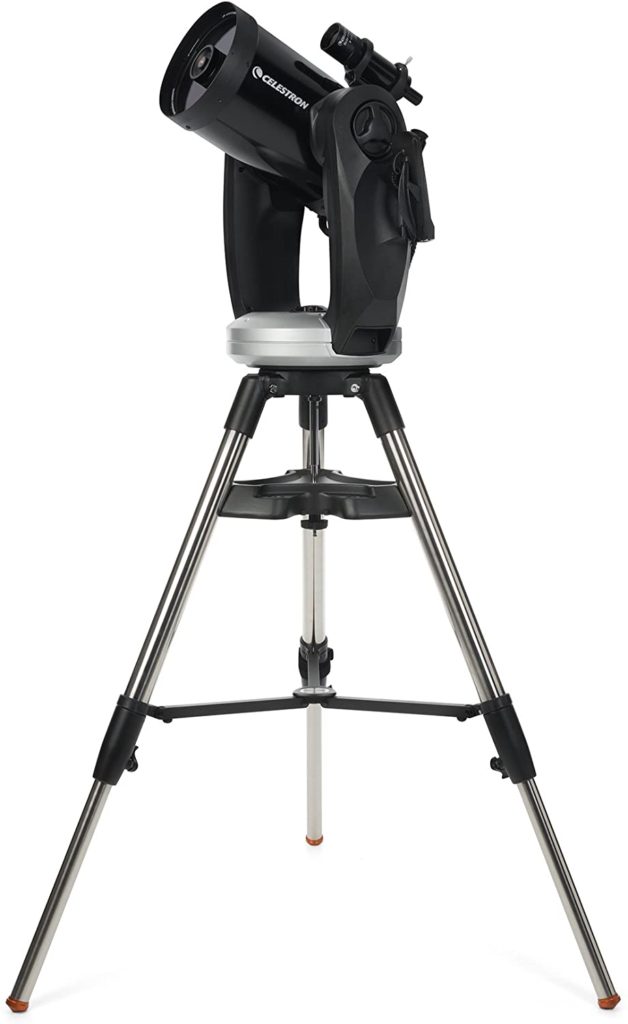
It comes with a 1.25″ star diagonal along with a 40mm Plössl eyepiece that yields 51x magnification. The motorized dual-tine fork mount has dual-axis servo motors that provide precision movements and an integrated 16-channel GPS receiver that sends information to the hand controller and requires limited input from the user.
The included stainless steel tripod helps reduce vibrations to ensure clear resolution during observation or imaging sessions.
The Celestron 800 XLT is one of the best computerized telescopes for astrophotography and deep space objects because of its extraordinary optics and heavy-duty mount.
Additionally, it comes with sturdy handles that allow you to comfortably lift and move the telescope from one location to another.
The large levers and knobs are easy to hold and use.
It also comes with a star diagonal that provides a more comfortable viewing position when observing deep space objects.
The Goto feature works well once all objects are aligned, also the hand control is easy to use while the button layout is also easy to master.
It’s convenient to be able to choose a variety of objects with the touch of a button. This means that even if you aren’t an expert on star names and constellations, you can still get to viewing right away. Also, needless to say, that the view from the scope is outstanding.
Pros:
- Easy to setup and use
- Amazing optics produce great quality images
- Perfect for astrophotography and viewing deep space objects
- The GoTo system is remarkable
- Tripod and mount are both extremely steady
- Light gathering capacity 843x greater than the human eye
Cons:
- Bright power light
- Doesn’t come with a power cord
Related
3. SkyWatcher S11800
- LARGE APERTURE: Get a bright, bold viewing experience at a fraction of the cost of other optical designs.
- INNOVATIVE COLLAPSIBLE DESIGN: Unique strut design allows for optical tube to collapse for ease of portability while keeping collimation.
- BUILT-IN WIFI: Control your telescope using a smartphone or tablet with Sky-Watcher’s proprietary built-in wifi signal.
- ALL METAL GEARING: Using all-metal gearing on a pair of DC servo motors, the SynScan Dobsonian combines the precise automated tracking of a computerized GoTo telescope with the bright large-aperture viewing of a Dobsonian.
- 94% REFLECTIVE MIRRORS: Fully multi-coated borosilicate primary and secondary mirrors deliver exceptional views.
The USP of the SkyWatcher S11800 GoTo Collapsible Dobsonian is that it is amazingly portable and is one of the best GoTo computerized dobsonians available in the market today.
This collapsible telescope features a patented truss tube system that enables the front corrector plate/eyepiece assembly to be moved back and locked against the main rear tube to reduce the size for storage and transportation.
Thanks to its collapsible truss tube, the scope becomes small enough to fit in most hatchbacks or on a back seat. It is truly portable, and once assembled, can be set up and ready to use in minutes.
The included SynScan computerized hand control is the brain behind the Sky-Watcher GoTo Dobsonian.
It allows you to point your telescope at a specific object, or even tour the night sky at the touch of a button!
With an internal database of more than 42,000 celestial objects, this easy-to-use hand control can locate any object you see in the night sky with push-button ease.
You can even let your Sky-Watcher GoTo Dobsonian take you on a tour of all the best objects based on your time and location.
In order to increase the light-gathering factor of this no-fuss scope’s mirror-based optical system, the two mirrors are coated with a layer of hard quartz and an additional layer of titanium dioxide.
The Sky-Watcher Dobsonian SynScan telescope has a patented dual encoder design incorporated to record the position of the telescope.
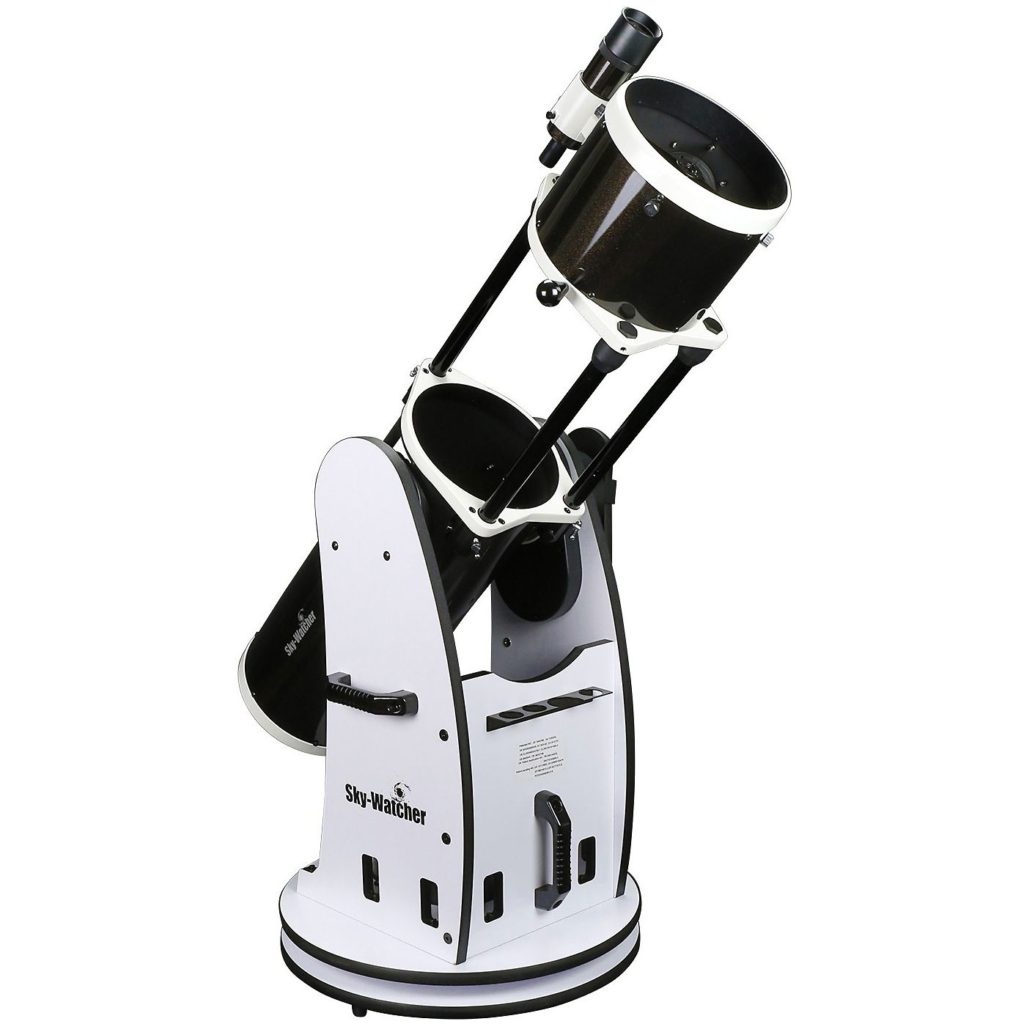
Under the Auto-Tracking Mode, you may choose to move the telescope, either manually or electronically, to any position without deactivating the tracking mode.
The AZ GoTo mode provides extensive computerized GoTo functions to assist you in finding and enjoying numerous celestial and deep space objects.
The 8-Inch Sky-Watcher Dobsonian SynScan is precision engineered telescope that will allow you to easily find and enjoy night sky treasures like Saturn, Jupiter, and other planets in the solar system, plug a huge array of deep-sky objects including galaxies, star clusters, nebulae, and more.
This Dobsonian was carefully engineered to combine ease of use, extreme portability and consistent performance in an affordable package.
No doubt, there are other truss tube designs, but the Sky-Watcher Collapsible Dobsonian does not need to be disassembled between uses.
It transports as two compact pieces that can be assembled, collimated easily and ready to use in just seconds.
Pros:
- Collapsible tube design for extreme portability
- Easy to setup and use
- Wide 8’ aperture and wide field view
- Best for dso, planets, galaxies and more
- Perfect for all-level users
Cons:
- Expensive
- No collimation tool provided
4. Celestron – NexStar 90SLT
- Computerized Star Locating Telescope: The Celestron NexStar 90SLT is a computerized telescope that offers a database of more than 40,000 stars, galaxies, nebulae, and more. The telescope locates your object with pinpoint accuracy and tracks it
- Compact and Portable: This telescope for adults and kids is ideal for weekend camping trips or excursions to dark sky sites. Its compact form factor makes it easy to transport and assemble just about anywhere
- Maksutov-Cassegrain Optical Design: The NexStar 90SLT is the smallest in the SLT family. The 90mm aperture gathers enough light to see our Solar System and beyond. View Saturn's rings, Jupiter's cloud bands, and the Moon in brilliant detail
- Fast Setup with SkyAlign: Celestron's proprietary SkyAlign procedure has you ready to observe in minutes. Simply center any three bright objects in the eyepiece and the NexStar SLT aligns to the night sky, ready to locate thousands of objects
- The NexStar 90SLT Computerized Telescope includes a free download of one of the top consumer-rated astronomy software programs for an interactive sky simulation
The Celestron NexStar 90SLT Black Mak Computerized Telescope is a perfect consideration for entry-level to mid-level astronomers. It is a compact instrument that possesses top-notch features at a reasonable price.
The Celestron NexStar 90SLT 90mm f/14 Maksutov-Cassegrain is one of the best affordable computerized telescope as it gives you the ability to make detailed observations of the Moon, with the ability to easily see planets and reach outside the solar system to resolve bright deep-space objects like galaxies, nebulae, and binary or variables stars.
With preassembled, adjustable stainless steel tripods, and quick release fork arms and tubes, NexStar SLT telescopes can be set up in a matter of minutes with no tools required.
The brain of the NexStar SLT is the venerable NexStar computer controller. Equipped with a database of over 4000 objects, including the planets, stars, nebulae, galaxies, and the complete Messier catalog, it can also be programmed with up to 99 custom user-defined objects and filters for custom object lists.
Its intuitive menu-driven user interface provides the power to observe the heavens with nine slew speeds and three tracking rates, plus anti-backlash compensation.
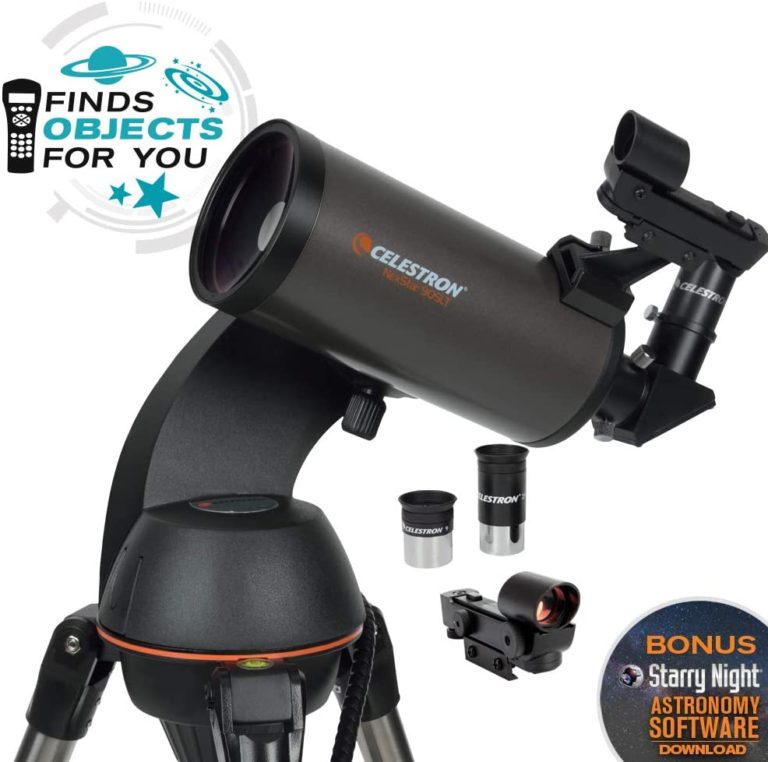
For users who want to learn more about the sky they are observing, the scope comes with Sky Astronomy Software. This software provides the user with information about the nighttime sky, celestial objects and sky maps to enrich the viewing experience.
The Maksutov-Cassegrain optical system’s Maksutov corrector lens is fully coated on both sides with anti reflective material for high light transmission and good contrast. A no-tool quick release dovetail connects the tube to the mount for fast set-up and take-down.
The scope comes with two eyepieces The first is a 25mm providing 50x magnification, which provides expansive views of the Moon, star clusters, and terrestrial observing. The second is a 9mm providing 139x for close-up views of the Moon and planets, globular star clusters, binary stars and more.
With the built-in SkyAlign technology, lining up your 90SLT on the sky each night takes only minutes. Simply input the date, time, and your location into the computer hand control, then use the StarPointer red dot finder to align the telescope on any three bright stars, or to two stars and a bright planet or the Moon. The NexStar computer will automatically align itself with the sky.
Pros:
- Excellent quality optics
- Compact, travel-friendly and portable
- Computerized go-to tracking
- Features “The Sky X” planetarium software
- Automatic alignment
Cons:
- Battery runs out quickly
5. Celestron – NexStar 6SE
- Control your telescope wirelessly from your iOS or Android smartphone or tablet with the free Celestron mobile app with planetarium interface and SkyAlign technology
- Compact, portable Schmidt Cassegrain telescope with StarBright XLT optical coatings and Fastar compatibility
- Computerized GoTo mount with high-performance worm gears and motors for improved tracking accuracy, along with reduced gear backlash
- Rechargeable lithium-ion battery with enough power for 10 hours of continuous observing
- Improved industrial design with manual clutches and integrated carry handles, plus the added convenience of two accessory trays and a USB charge port for your smart device
The NexStar 6SE offers consumers the proven quality of the Celestron brand in a compact, portable, and technologically advanced telescope.
Click here to read Celestron NexStar 6SE’s full review.
The scope’s 6-inch aperture, portable design, fully functional computer, and extensive database, among other features, make it easy to use, easy to transport, and easy to enjoy regardless of experience level. The NexStar 6SE is quite evidently the best celestron telescope under $1000 on our list.
The NexStar 6SE is a 6-inch Schmidt Cassegrain Telescope, which has an actual aperture of 150 mm and focal length of 1,500 mm, giving it a focal ratio of f/10. The OTA comes on a Vixen-style dovetail bar, which fits into the dovetail saddle on the mount.
The telescope also comes with a 1.25” prism diagonal, 25 mm Plossl eyepiece (providing 60x when used with the 6SE) and Celestron’s StarPointer, which is a zero-power red-dot-style finder.
The Celestron NexStar 6 SE is a solid and sturdy telescope, perfect for home use and astrophotogaphy.
The Celestron NexStar 6 SE is easy to align with Celestron’s SkyAlign Go-To Alignment system.
On average it takes a new telescope user approximately 5 minutes to do a full sky alignment with the NexStar 6 SE.
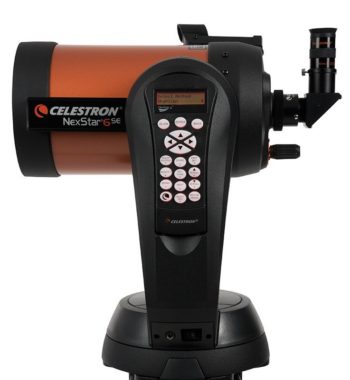
Once aligned, the telescope is incredibly easy to operate. The hand controller on the NexStar 6SE allows you to move the telescope at your discretion. If you are looking for a telescope that can help you transition from beginner to a bit advanced astronomer without much guidance then look no further than the NexStar 6SE as it one of the best rated computerized telescope that money can buy.
The NexStar 6SE’s hand controller offers a tour of the night sky and easily allows you to locate planets, galaxies or any of the 40,000 celestial objects in its database.
To power the 6SE you have two options, 8x AA batteries or 12v DC power supply. The 8x AA batteries would last you about 3 hours (included alignment of finderscope and general terrestrial viewing and the 40 minute observation session).
You can download all the available upgrades from Celestron’s website. In this way, you can keep your telescope up to date, and you can even control your telescope via computer.
The 6SE makes a good choice for consumers living in areas with light-pollution who are looking for clarity and accuracy in their viewing experience.
It is also one of the best telescopes for beginners under $1000 who are willing to invest a fair sum of money into the hobby in order to learn more about the star gazing experience. Also, the 6SE is a good choice even for more experienced star gazers who wish to have a more portable scope for easier transport and for viewing deep space objects.
Pros:
- Easy to mount and to use
- Good optics
- It’s very sturdy and low maintenance
- Motorised and automated GoTo mount
- Portable, fits perfectly in the back of any normal car
Cons:
- 8 AA batteries tend to drain out fairly quickly
- User manual and instructions are not very clear
6. Celestron – 114LCM
- COMPUTERIZED AUTOMATIC TELESCOPE: The Celestron 114LCM Computerized Newtonian Telescope with all glass optics can automatically locate 4,000 celestial objects with its computerized GoTo mount.
- TAKE THE SKY TOUR: If you’re not sure of what to observe, the Sky Tour button will do the work for you. Simply press the button and your computerized telescope will generate a list of the best objects currently available to view in the sky.
- EVERYTHING YOU NEED: The Celestron LCM telescope comes with everything you need for stargazing, including a full-height tripod, 2 high-quality eyepieces (25mm & 9mm), and a StarPointer red dot finderscope.
- BONUS FREE STARRY NIGHT SOFTWARE: This Celestron 114LCM Computerized Telescope includes a FREE download of one of the top consumer rated astronomy software programs. Simulate the night sky from any location on Earth or plan your next observing session.
- UNBEATABLE WARRANTY & SUPPORT: Buy with confidence from Celestron, a leading telescope brand in California since 1960. Your purchase includes a 2-Year US Warranty and unlimited support from our team of US-based experts.
The Celestron 114LCM 114mm f/9 Computerized GoTo Reflector Telescope features a 114mm diameter parabolic primary mirror that is coated with highly-reflective aluminum to allow for detailed observation of the Moon and planets, with the ability to reach outside our solar system and view binary stars, clusters, galaxies, and nebulae.
The 114LCM consists of an optical tube with a 4.5-inch mirror and a focal length of 1000mm giving a focal ratio of f/9. It has a basic rack and pinion focuser that takes 1.25-inch eyepieces: 25mm and 9mm eyepieces are provided giving magnifications of 40x and 111x.
The Celestron 114LCM has over three and a half times the light gathering capacity of a typical 60mm starter scope. That means visibly brighter deep space images and the ability to see many more faint objects than a 60mm scope could ever hope to show.
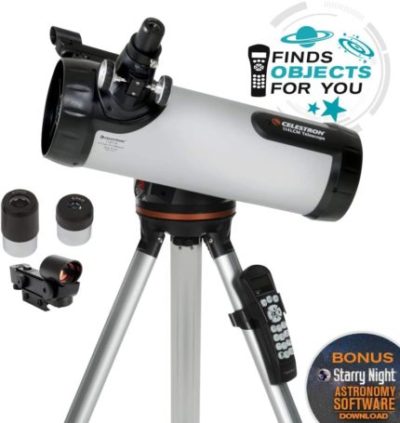
It has 90% more resolution than a 60mm scope as well, to let you see more sharper and detailed views of the Moon, planets, binary stars, and star clusters.
A built-in StarPointer red dot finder helps to aim the telescope, especially during the alignment phase.
The tube is attached to the motorised base via a Vixen-style mounting bar that connects to the aluminium tripod using a bolt on the underside.
The Celestron 114 LCM is one of the best budget computerized telescopes for viewing planets and galaxies and it comes with a standard StarPointer red dot finder and an extremely short orange anodized aluminum Vixen style dovetail.
The NexStar+ LCM hand controller lets you control, align and operate the telescope. It has a database of 4,000 targets including Solar System, Messier, NGC and Caldwell objects, along with double stars, variable stars and more.
The telescope features a single fork arm altazimuth design with pre-installed enclosed dual DC servo motor drives.
A compartment in the drive base accepts eight user-supplied AA batteries for powering the telescope. An optional AC adapter and rechargeable battery pack are available to conserve battery life.
The preassembled tripod has aluminum legs to damp vibrations quickly. The center leg brace holds a convenient no-tool quick-release accessory tray to keep your eyepieces and accessories.
Pros:
- Beginner friendly GoTo telescope
- Decent optics
- Free download of astronomy software programs for an interactive sky simulation
- Multiple accessories
Cons:
- Weak battery life
- Calibration can take some time
8. Celestron NexStar Evolution
- Control your telescope wirelessly from your iOS or Android smartphone or tablet with the free Celestron mobile app with planetarium interface and SkyAlign technology
- Compact, portable Schmidt Cassegrain telescope with StarBright XLT optical coatings and Fastar compatibility
- Computerized GoTo mount with high-performance worm gears and motors for improved tracking accuracy, along with reduced gear backlash
- Rechargeable lithium-ion battery with enough power for 10 hours of continuous observing
- Improved industrial design with manual clutches and integrated carry handles, plus the added convenience of two accessory trays and a USB charge port for your smart device
The Celestron NexStar Evolution 8 Computerised Cassegrain telescope is a large Schmidt Cassegrain.
It has a large 203.2mm (8″ aperture) and 2032mm focal length.
With these specifications, this telescope is capable of reaching high magnifications (480x) suitable for viewing planets and deep sky objects.
The Nexstar Evolution 8 EdgeHD Telescope from Celestron features integral Starsense auto alignment, WiFi and internal Lithium ion battery.
This high end telescope has a variety of premium features:
8” EdgeHD optics that provide a flat field with pinpoint start all the way to the edge of field, resulting in superb visual and astro-imaging performance
Rechargeable lithium-ion battery for a power source that can provide up to 10 hours of continuous observing
Built-in WiFi that connects directly to your smartphone or tablet — no handset required
StarSense auto align technology provides a hands-free automatic experience, aligning your telescope within two minutes of startup
The telescope features a NexStar evolution mount with a variety of features, including manual release clutches, precision worm gears, eyepiece tray lighting, a USB charge port and more
The NexStar Evolution 8-inch EdgeHD with StarSense is the best computerized telescope for cloudy nights and it also produces high quality images even when confronted with light pollution.

It gives you the best of two worlds with the coming together of EdgeHD optics and StarSense AutoAlign.
This innovative telescope allows you to control your telescope wirelessly via Celestron’s SkyPortal app to your smartphone or tablet.
The 8-inch NexStar Evolution HD is one of the best telescopes for astrophotography on our list.
It is the only fork-mounted telescope in its price range that offers brass worm gears, along with improved motors.
You can capture images of deep-sky objects like the Orion Nebula by simply attaching your DSLR camera.
The EdgeHD optical system is designed to virtually eliminate spherical and chromatic aberrations so views through it are flat and distortion-free across the entire field of view, with accurate color rendition.
Using Celestron’s proprietary StarBright XLT multi-coating system, light transmission is increased throughout the entire optical path with anti-reflection multi-coated lenses, highly reflective multi-coated mirrors, and four-element rare-earth glass.
Pros:
- Easy to set up, use and super accurate
- For its size the scope and mount are light and portable
- Easy alignment process with clear instruction manual
- Produces amazing images even in cloudy nights and light pollution
Cons:
- On rare occasion the telescope loses wireless connection with your device
Best Computerized Telescope; Buying Guide
The best computerized telescope is one that guides you through the process of learning the night sky in a straightforward and gratifying way.
Here is a comprehensive GoTo computerized telescope buying guide which will explain the importance of all the parts of a telescope and the important features that you should look for when purchasing the telescope.
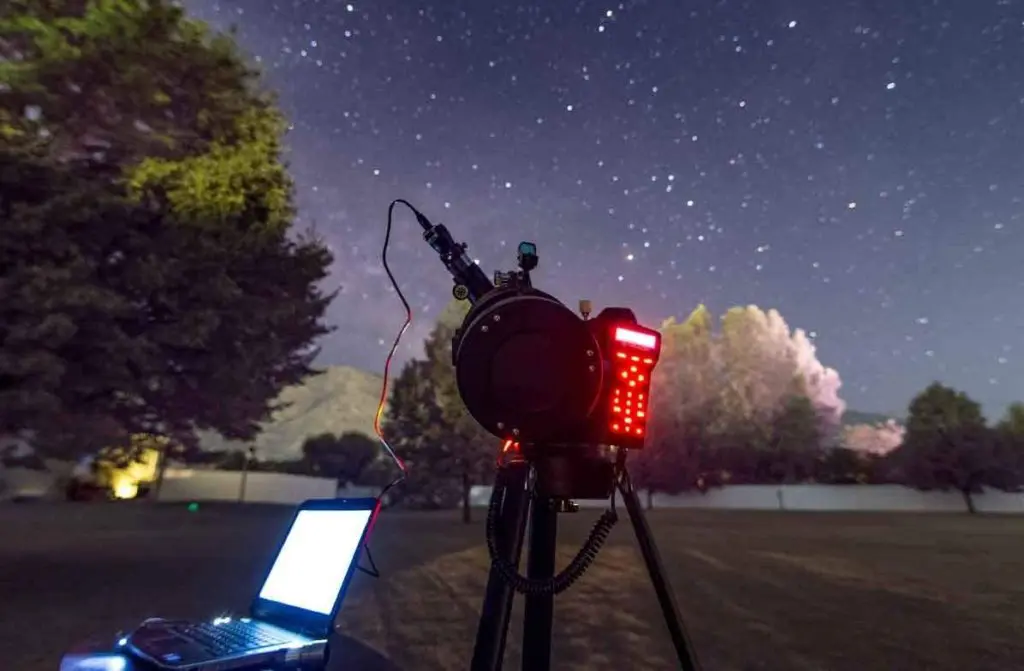
Features To Consider When Choosing A Good GoTo Computerized Telescope
Aperture
The most important aspect of any telescope is its aperture, the diameter of its main optical component, which can be either a lens or a mirror.
A scope’s aperture determines both its light-gathering ability (how bright the image appears) and its resolving power (how sharp the image appears). When learning how to choose a telescope, knowing all you can about the aperture is crucial to your ability to see the night sky.
This simply means – the bigger the aperture the better. With a 6-inch telescope you can discern craters on the Moon as small as about a mile across — half the size of those visible in a 3-inch scope (under the same conditions using the same magnification).
The same two instruments turned toward a faint galaxy on a moonless night would tell an even more dramatic story. Because the surface area of a 6-inch mirror is four times that of a 3-inch mirror, it collects four times as much light, meaning the galaxy would appear four times brighter.
Focal Ratio
The focal ratio (f/5.9 for example) is the ratio between the aperture and the focal length. Multiply the aperture by the f ratio to find the focal length.
Focal Length
Focal length is the distance between a telescope’s primary optics and the image it creates. A longer focal length is more suited for observing planets, while a shorter focal length is better for wide field views of space.
Magnification
The magnification (power) of a telescope is variable and depends upon the eyepieces one uses. The power is computed by dividing the focal length of the primary objective (aperture) of the telescope by the focal length of the eyepiece being used.
Eyepieces
Eyepieces are fundamental components of a telescope and each telescope comes with at least one eyepiece. The eyepiece of a home telescope defines the magnification power and field of view of that telescope.
The magnification power of eyepieces differs from one eyepiece to another based on their focal lengths as well as their field of view.
An eyepiece is rated by millimeters, with smaller numbers indicating higher magnification. A 25-millimeter eyepiece is common and appropriate for most stargazers.
Weight
The size and weight of the telescope you are willing to carry is probably the biggest problem one must ponder.
Telescopes can range from around 15 lbs. to well over 300 lbs. Most can be broken down into 3 subsections for transportation: the optical tube assembly, the telescope mount, and the tripod or base. Remember, if the scope is too heavy, you may not use it at all.
Conclusion
Our top pick for the best computerized telescope for beginners is the Celestron – NexStar 5SE Computerized Telescope. Its 5-inch aperture provides excellent light-gathering ability at an affordable price. You’ll get impressive views of the Moon and planets, along with deep sky objects like the Orion Nebula, while retaining a compact form factor.
Fully automated GoTo mount with a database of 40,000+ celestial objects automatically locates and tracks objects for you.
Our next best computerized telescope for astrophotography is the Celestron EdgeHD 800 XLT. The telescope is a remarkable optical tube assembly, built to satisfy astrophotographers, but also suitable for superior visual observing.
Celestron’s EdgeHD Optical Tube is a Aplanatic Schmidt Telescope design producing aberration-free images across a wide visual and photographic field of view.
ABOUT US
We are a team of active amateur astronomers, here to help you with all your astronomy and science related needs – this is anything, from reviewing the latest telescopes to be released to talking about gravity and neurons. The Big Bang Optics was started because of our love for astronomy and to help others like us find the best telescope and accessories.
LEGAL DISCLAIMER
The Big Bang Optics is a participant in the Amazon Services LLC Associates Program, an affiliate advertising program designed to provide a means for sites to earn advertising fees by advertising and linking to Amazon.com. The Big Bang Optics also participates in affiliate programs with Clickbank and other sites. The Big Bang Optics is compensated for referring traffic and business to these companies.







